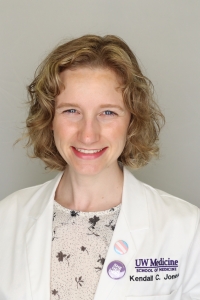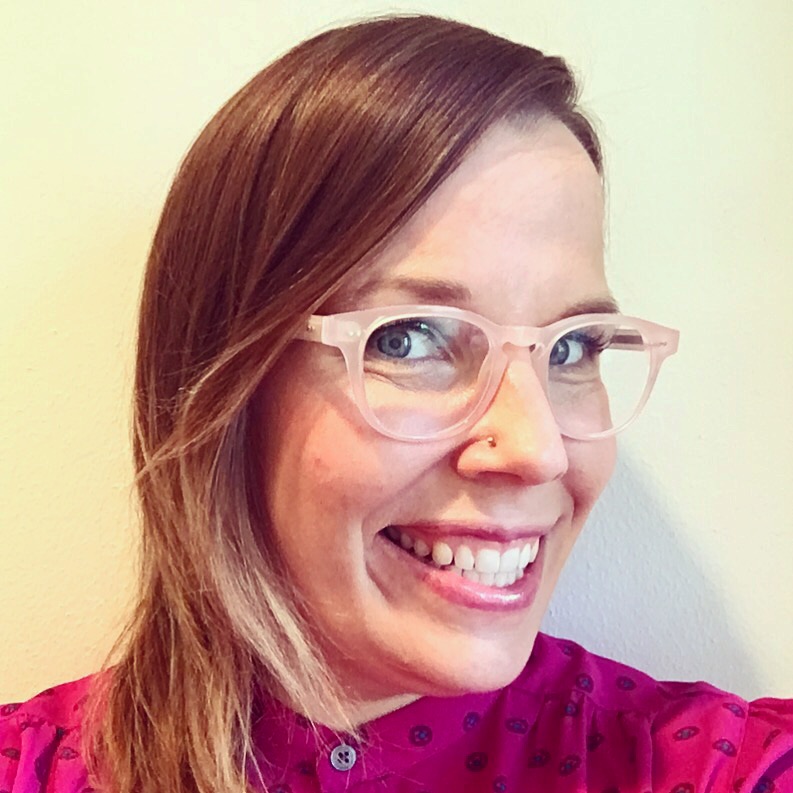
“There are strengths and weaknesses associated with introverted traits and with extroverted traits. Extroverts thrive in social situations, can rapidly form relationships with team members, and are comfortable with spontaneous brainstorming, thinking aloud and offering ideas quickly and assertively. Introverts’ strengths include thoughtfulness, listening, humility, and forming deep connections. They process internally, share fully formulated thoughts, and prefer to avoid bringing attention to themselves.”
—Kendall Jones, University of Washington School of Medicine
by Kendall Jones, University of Washington School of Medicine
When I meet a patient in clinic, I am in my comfort zone, focused on connecting and creatively problem-solving. But when I leave the exam room, I feel overwhelmed and misunderstood—my mind races as I struggle to communicate my thinking. Patient care settings can be chaotic and the requirement to perform on-the-spot for evaluators frequently does not create a learning environment that accommodates introverts.
While improving the learning environment for students from all backgrounds is an ongoing effort in medical education, I haven’t heard discussion about the experience of introverted students in clinical rotations. The current model of clinical phase medical education frequently does not create a safe learning environment for introverted students. For me, this has contributed to a negative cycle of anxiety and underperforming. Patients appreciate my careful listening and thoughtful responses. But in a rushed clinic, I feel any information I can share is treated as redundant. As I present, I feel concerned about taking up too much space despite the importance of this presentation for my grade. Preceptors observe my hesitancy and lack of self-assuredness and interpret it as failure. But confidently voicing my thinking process is much more difficult “on stage” than in a real-life patient-care setting. Awful feelings related to these experiences day-in and day-out are a significant challenge: I observe myself reaching burnout faster than other classmates, and I worry that I don’t have the energy-levels, constitution, and extroversion required to succeed in medical school and residency. However, I found that research and commentaries validate my feelings and experiences. I am not alone.
Over the course of the last three decades, the Center for Research in Medical Education and Health Care has investigated medical student personality and personal characteristics and correlations with student success and patient care. In 2004, they found that greater self-esteem and higher scores of extroversion could predict global ratings of clinical competence in core clerkships in medical school. Systematic reviews support the finding that introverted students tend towards poorer evaluations related to interpersonal behavior during clerkship rotations. 1 In 2005, Davis and Banken identified significant positive correlation of extrovert traits with clinical performance in an OBGYN clerkship but no correlation with performance on the standardized subject exam, consistent with other studies finding lack of correlation between more subjective clinical evaluations and more objective measures of clinical knowledge. They thus questioned, as have others before, whether clinical evaluations should be included in the overall evaluation score or if they should be labeled ‘interpersonal skills’ rather than ‘clinical evaluation’ to more accurately describe what the evaluation reflects. 2 Surveying nearly 3,000 students who completed core clerkships, Lee et al. found that more reserved students were more likely to report lower grades while more assertive students received lower grades less frequently. 3 A possible mediator for these findings is extroversion. This allows students to demonstrate their enthusiasm and knowledge to their evaluators which can improve their subjective grade. Another explanation is that the stress of constantly trying to impress evaluators has a greater effect on introverted students while extraverted students are more at ease; introverted students are known to feel less comfortable expressing themselves in high-pressure environments and are inclined to hold back and speak only if they are 100% sure of themselves. 4, 5 While inferior evaluations can affect students’ chances at residency, the challenge of having an introverted tendency in medical training can negatively affect students’ health as well.
Multiple studies have shown an association of introversion with burnout. 6, 7 Qualitative research agrees with these findings with introverted students reporting feeling like ‘misfits’ and that they must change their identities to succeed in medical school. 1 Introverts report working to make others comfortable at the expense of their own comfort and energy levels. 1 When introverted students experience medical training invalidating their innate style of thinking and social engagement, they are more likely to experience chronic stress and anxiety. Leadership research finds that both introverts and extroverts lend important and distinct contributions to teams. 8 Learning environments ought to be tailored to fit students who fall anywhere within this temperament spectrum.
There are strengths and weaknesses associated with introverted traits and with extroverted traits. Extroverts thrive in social situations, can rapidly form relationships with team members, and are comfortable with spontaneous brainstorming, thinking aloud and offering ideas quickly and assertively. Introverts’ strengths include thoughtfulness, listening, humility, and forming deep connections. They process internally, share fully formulated thoughts, and prefer to avoid bringing attention to themselves. In clerkships, extraverted traits are beneficial for adapting to the constant rotation of locations and team members. Extraverted students are likely to be more comfortable with presenting information in quick succession and processing this information as they speak, whereas introverts desire to thoroughly gather information and feel a need for focused time to formulate assessments before sharing them with others. Not only are extroverted traits are preferred in clinical rotations, they are preferred in modern Western society as a whole. As noted by Davidson et. al., “This trend of devaluing or pathologizing introverted behavior has been noted in national studies and is emphasized in Susan Cain’s best-selling book on introversion (Quiet: The Power of Introverts in a World that Can’t Stop Talking9) that Western society has shifted from appreciating a thoughtful approach of interaction with others to a more demonstrative social and assertive approach.” Natural introverts sense these preferences, and this can negatively affect students’ self-esteem. Introverts can try to act more extroverted, but this adds yet another obstacle in an already challenging environment.
In a review of literature, Davidson et. al. find that when a student’s personality and behavioral characteristics are harmonious with the learning environment this typically results in optimal performance, while an incongruent fit can lead to maladaptive behavior. 1 Unfortunately, this is personal for me—in the fast-paced, high-pressure, zero-continuity environment of clinical clerkships my introversion and anxiety increase. I’m evaluated as underperforming; I feel bad about myself, and I don’t recognize myself—someone who, when in a familiar environment, is passionate and conversational. But my brain is plastic and I have hope. I can remember the times when the learning environment was a good fit and I rose to the occasion and was recognized for what I truly have to offer. A bad fit was the rushed environment of a busy family medicine residency clinic where we were always behind and I didn’t want to hold anyone up. When I felt I had to choose between addressing the patient’s foremost concerns and impressing my preceptor, I struggled. But on inpatient medicine I knew what to expect— my attending gave me a defined time to plan for my admit and prepare to present; I was rewarded with the affirmation that my plan was nearly exactly what he would have done. The residents on the team gave daily helpful feedback allowing me to improve more during the next day’s rounds. I felt encouraged and supported in my growth as a student doctor. Unfortunately, I can’t say the same for other places I rotated.
I know the learning environment and I both have room for improvement, and we can meet in the middle. I will fight my learned anxiety with everything I can and will work on cultivating extraverted skills including thinking aloud, assertiveness, and sharing ideas before I’m 110% sure, even though it’s uncomfortable. But I demand better from the learning environment: in some patient-care settings, it feels as if there is little thought towards the goal of fostering the growth of student doctors. Showing support, encouragement and a little bit of empathy for students goes a long way, as does setting clear expectations and allowing time and space for the introverts to prepare and feel comfortable, whenever possible. If the student appears anxious, avoidant or introverted, try to meet them where they are rather than turning a blind eye. After all, as Lebin et. al. write, “the inclusion of both introverts and extroverts in leadership roles strengthens teams, departments, and organizations. We therefore champion embracing introversion in trainees, colleagues and, most importantly, in ourselves.” How can you better recognize introverted students for their thoughtfully, albeit more deliberately-formed ideas? How can you provide encouragement and attention to creating opportunities for these more reserved students to prepare and present their knowledge and reasoning?
References
- Davidson, B., Gillies, R. A., & Pelletier, A. L. Introversion and Medical Student Education: Challenges for Both Students and Educators. Teaching and Learning in Medicine, 2015; 27(1), 99-104. https://www.tandfonline.com/doi/abs/10.1080/10401334.2014.979183
- Davis K. R., Banken J. A. Personality Type and Clinical Evaluations in an Obstetrics/gynecology Medical Student Clerkship. Am J Obstet Gynecol. 2005 Nov;193(5):1807-10. doi: 10.1016/j.ajog.2005.07.082. PMID: 16260239.
- Lee, K. B., et al. “Making the Grade:” Noncognitive Predictors of Medical Students’ Clinical Clerkship Grades. J Natl Med Assoc. 2007; 99, pp. 1138-1150
- Noureddine L., Medina J. Learning to Break the Shell: Introverted Medical Students Transitioning Into Clinical Rotations. Academic Medicine. 2018; 93 (6): 822-822. doi: 10.1097/ACM.0000000000002222.
- de Jongh, R., de la Croix, A. 12 Tips to Hear the Voices of Introverts in Medical Education… and to Improve the Learning Climate for Everyone. MedEdPublish, 2021; 10(107), 107. https://mededpublish.org/articles/10-107
- Ramachandran, V., et al. Myers-Briggs Type Indicator in Medical Education: A Narrative Review and Analysis. Health Professions Education. 2020; 6(1), 31-46. https://www.sciencedirect.com/science/article/pii/S245230111830124X
- Hojat, M., Erdmann, J. B., & Gonnella, J. S. Personality Assessments and Outcomes in Medical Education and the Practice of Medicine: AMEE Guide No. 79. Medical Teacher, 2013; 35(7), e1267-e1301. https://www.tandfonline.com/doi/full/10.3109/0142159X.2013.785654
- Lebin, L. G., Riddle, M., Chang, S. et al. Continuing the Quiet Revolution: Developing Introverted Leaders in Academic Psychiatry. Acad Psychiatry. 2019; 43, 516–520. https://link.springer.com/article/10.1007/s40596-019-01052-8
- Cain S. Quiet: The Power of Introverts in a World That Can’t Stop Talking. New York, NY: Crown/Random House, 2012.


